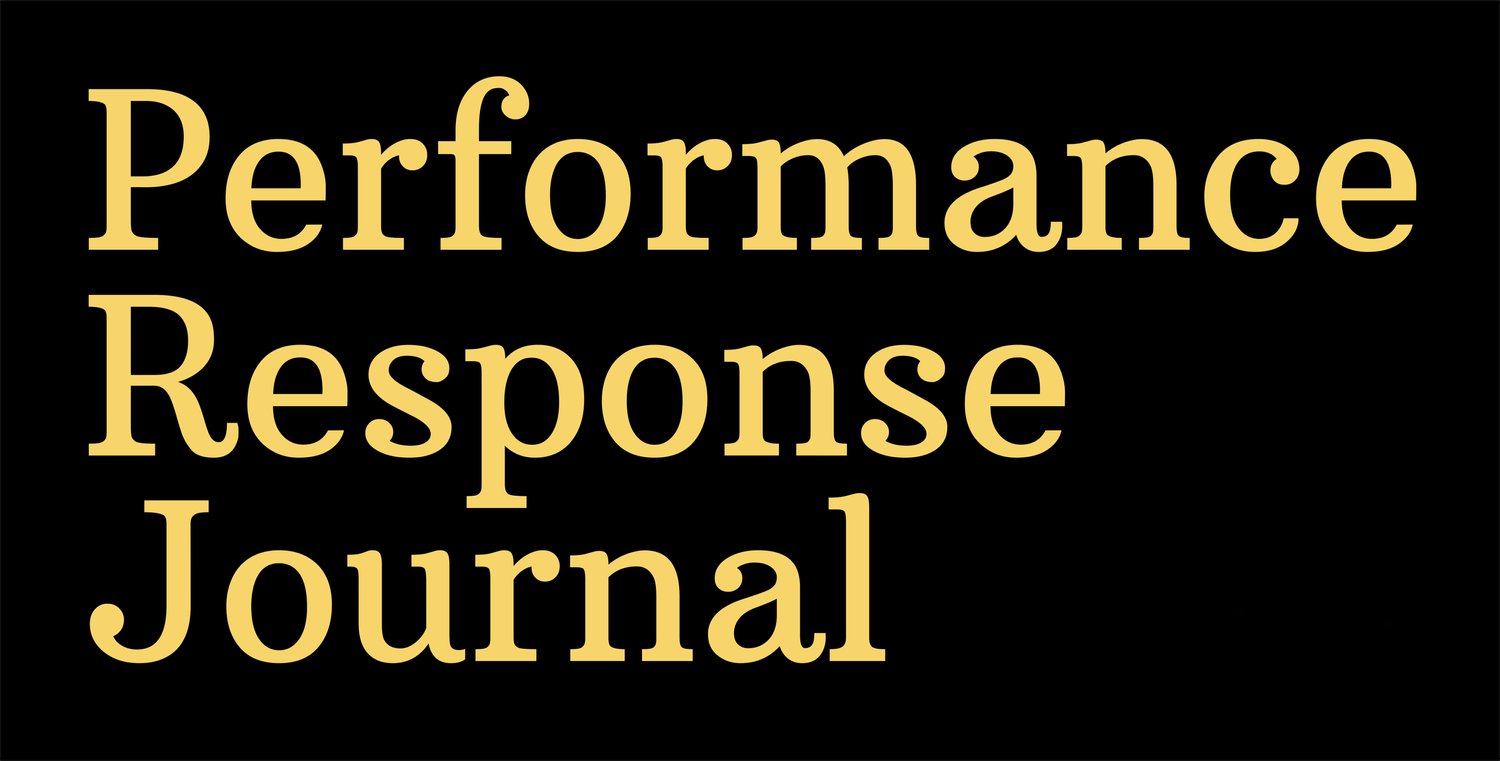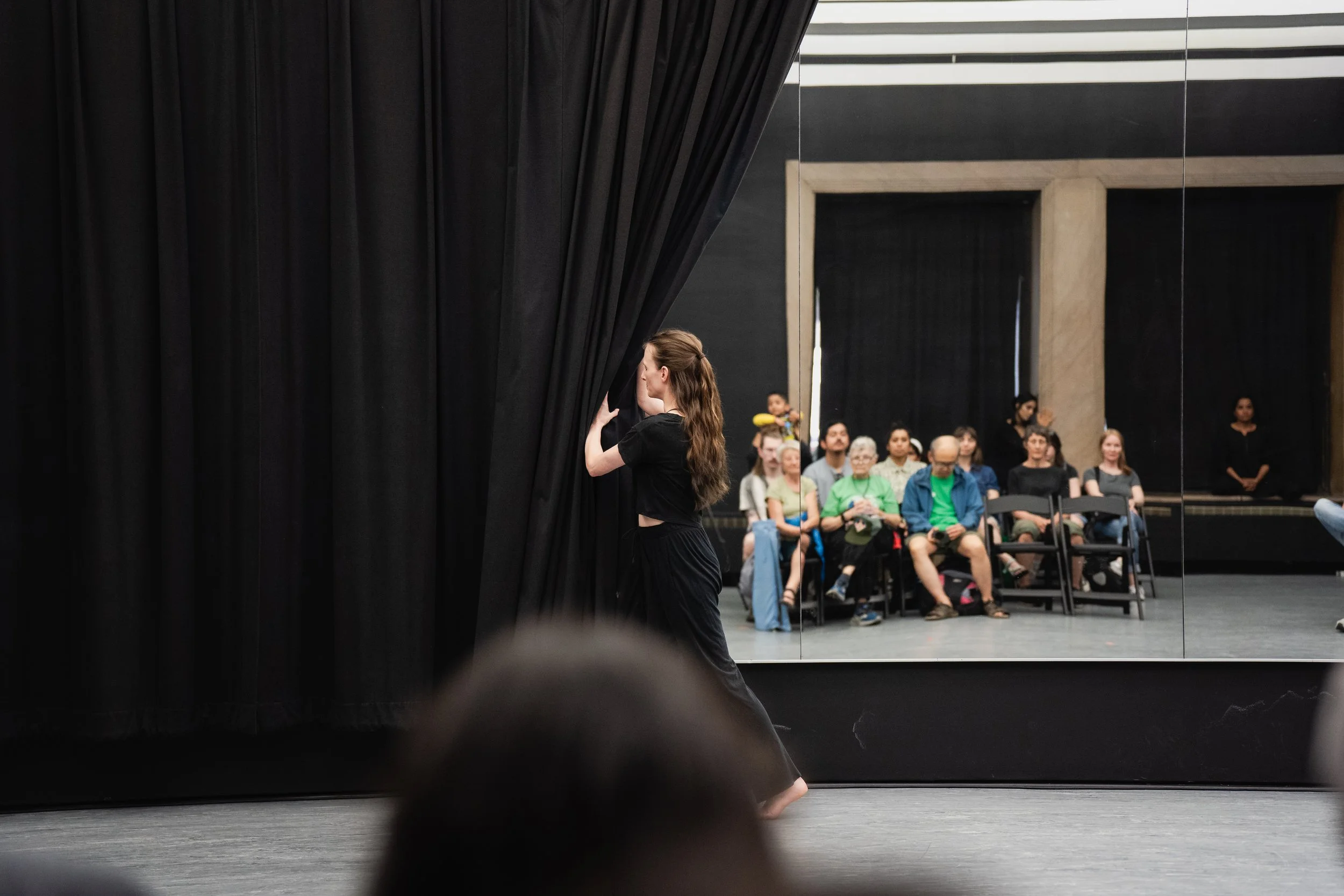The work of dance-in-progress: a response by Ameera Nimjee
Image captured by Ricardo Adame
Seen/Unseen
Presented by Ishti Collective
Artistic Co-Leads: Chitra Nair, Lauren Reed, Preeti, Veerlapati, Kinnari Vora
Performance: Chih-Jou Cheng, Ashwaty Chennat, Chitra Nair, Daniele Obiltas, Lauren Reed, Ashaand Simone, Preeti Veerlapati, Kinnari Vora
Original score: Bob Garrett
Performed as a work-in-progress at the Chicago Cultural Center on June 8, 2025 through the cultural center’s Dance Studio Residency
**************************
The din of chatter dies away as dancer Lauren Reed pushes the curtains open, revealing the long, mirrored back wall of the Chicago Cultural Center’s dance studio. This concerted gesture marks the beginning of an “open studio” showing of Seen/Unseen, the most recent work in Ishti Collective’s repertoire. Founded in 2016 by dancers Preeti Veerlapati and Kinnari Vora, Ishti presented this work-in-progress on June 8, 2025, following a few months in residency at the Chicago Cultural Center to conceive the piece as a commentary on the labor of care work. In true Ishti form, Seen/Unseen was led collaboratively by Kinnari, Preeti, Lauren, and Chitra Nair, who designed creative prompts and choreography for an ensemble of eight dancers and a musical composer. The dancers performed “seen” versus “unseen” gestures of care along with the emotional journeys that come with doing care work, especially from the perspective of the often gendered caregiver.
Perched on stage left in the front row of the studio’s audience, I saw the piece come together from the fragments I had seen in rehearsal in the days leading up to the showing. Undetectably, four of the dancers moved behind the audience and onto the ledges that framed the studio’s four windows. Reflected almost in silhouette, they moved in angular shapes, working against the four walls of these temporary, vertical stages. I heard the familiar, diatonic melody hum emanating from them, and the rest of the dancers dispersed throughout the studio, marking this opening section’s six-beat pattern. The dancers hummed this earworm melody to keep count, a self-produced musicality that united their starts and stops as the dancers eventually melted toward the studio “stage.” Primed by the unfolding attention to care work in Seen/Unseen, I reflected on the work of doing dance—of what it takes to dance, of its toll on the body, and how much of it we show in performance. Itself a placeholder title for the piece, Seen/Unseen draws my attention to what an in-progress work reveals for tracking dance as work. What becomes “seen” within the permissive space of the in-progress showing—of performing a work that is not a finished product?
Throughout the performance, I zoned in on the vocabulary of the work, rooted in some of the stylized aesthetics that characterize “Indian classical dance.”[1] In Preeti and Chitra’s duet, I felt myself descend into their mimed expressions of motherhood, in which they showed the intoxicating love; fatigue of endless nights; and exhausting, enduring anxiety in abhinaya, where the face performs poetic exegesis in stylized movements of the eyes, eyebrows, and hands. I tapped along with the rhythmically driven sections of jathiswaram in a seven-beat “ta-ki-ta, ta-ka-di-mi,” which the dancers recited onomatopoeically as their feet articulated this pattern on the floor. Of course, these vocabularies took shape in fluid ways that are reminiscent of other Ishti works, as interspersed with the suspend-releases of contemporary technique and movement improvisations that are as multiple stylized as the diverse movement backgrounds of the Collective’s members.
Image captured by Ricardo Adame
In the days leading up to the studio showing of Seen/Unseen, I clocked references to the piece as a work-in-progress—a checkpoint in the creative work that the Collective had done to that point. In rehearsal, the opening hum constantly slowed down, which a dancer often remedied by snapping their fingers faster, or calling out the hum’s intended tempo, counting in sixes to keep everyone moving. In the studio showing, I heard the counted sixes come through a few seconds in just below the hum, a beautifully natural moment of transparency into the aesthetic-functional role of this melody. In the jathi (rhythmically technical) section, the dancers recited the bols (words) “ta-ki-ta ta-ka-di-mi” in a driving loop of a seven-count phrase. The creative intention was for this recitation to fall away, with the dancers’ feet slaps marking this lilt to keep driving. The same bols resounded in the studio showing, as the dancers again produced their own musical texture, not yet ready to fall away and instead pointing our attention to this relentless rhythm. In rehearsal, Kinnari informed the dancers that portions of the track would be played “live” since there was no time to lay down a recording. The showing featured composer Bob Garrett seated behind his rig: a laptop, pocket synthesizer, mixer, and mic into which he improvised live on kanjira, a hand drum that provided a rhythmic counterpoint to the choreographed jathis.
These musical moments became invitations into the work as a process—as moments of seen labor that performers clean up when dance is a proscenium product. Having danced the Indian classical form kathak for almost two decades, I have found myself frustrated by the often-separated aesthetic worlds that comprise “music” and “dance” in the Euro-American West. The recitation of bols, collaborative improvisation, and the bare necessity of live music are but a few examples of the aesthetics that drive the performance of Indian classical music-dance. Seen/Unseen showed us that danced musicality is not just an essential part of Ishti’s process but allows a fuller, “seen” picture into aesthetics in spaces that are concertedly not for dance-as-product.
“What’s next?” I asked Kinnari, in a conversation we had the night before the showing. I was to moderate the artist talkback just following the performance, and we met to discuss it. She explained that the audience’s participation is a crucial part of Ishti’s creative process. In Seen/Unseen, this participation came in the form of feedback, while in other Ishti pieces, audience interview excerpts have featured in the track or the audience has been invited into design elements of a piece, like making rangoli or lighting a lamp. For Ishti, the audience must have a stake in a performance, as if they are extended members of the Collective. During the talkback, the discussion dwelled on Lauren’s introductory gesture of opening the studio mirror’s curtains, which the audience took to be significant. The dancers affirmed that it was, in many ways: as rendering “unseen” work visible and the very suggestion resulting from previous audience-ensemble dialogue.
The talkback became an extension of what the in-progress showing afforded: a space to lay the work of dance bare for performers and audience alike. I brought up the aesthetic concepts of shauq (passion) and rasa (flavor) in the South Asian performing arts, which outline that performers and audience members construct a performance in an affective exchange of moods and emotions. A performance is a shared labor, which Ishti Collective made even more transparent as they invited us into their work-in-progress, as not yet “done.” In the final movement sequence of Seen/Unseen, the ensemble performs a series of vignettes through which they express a multiplicity of care work and the emotional journey through it. They end in a tableau that remains alive and moving. Their bodies breathe, lean, shudder, and support. They invite us to really see this labor, not just in the content they perform in the work, but in the presentation of the unfinished work-in-process. The work thrives in a non-proscenium space of shared labor, as the audience is given an intimate glance into what it takes to make dance.
Image Captured by Ricardo Adame
[1] Indian classical dance is an umbrella term for styles like bharatanatyam, kuchipudi, and kathak. Their aesthetics emphasizes mime and the percussive use of the feet. Popular narratives of “classical dance” often refer to their ancient roots in performing Hindu devotion. These narratives have grown from the post-1947 Indian nation-building project, which saw the caste appropriation of repertoire from among courtesan vernacular dance. See, for example, Pallabi Chakravorty’s Bells of Change (2008) and Davesh Soneji’s Unfinished Gestures (2011).
**************************
Ameera Nimjee is a musician, dancer, scholar, and educator. A member of Toronto-based Chhandam Dance Company, she performs kathak under the tutelage of Joanna de Souza. She holds a Bachelor of Music and Associate's Diploma in classical piano performance. She has also completed MA and PhD degrees in ethnomusicology. Currently, Ameera is an assistant professor in the Departments of Music; Theater, Dance, and Performance Studies; and South Asian Studies at Yale University, where she teaches courses on performance and culture. She is writing a book on creativity and labor Indian contemporary dance.




